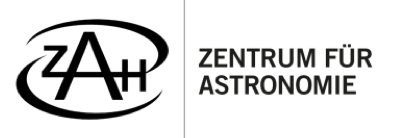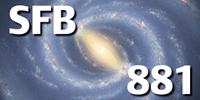Subproject P03: Secular sub-structure in the Milky-Way disc
Subproject P03: Secular sub-structure in the Milky-Way disc
Walter Dehnen (ARI)
The Gaia satellite mission and terrestrial follow-up surveys are currently measuring the phase space structure of stars in the Milky Way disc. These surveys have already revealed a high degree of structure in the distribution of horizontal/in-plane motions (also in vertical motions, but these are not focus of this project), showing grooves and ridges. These structures are commonly interpreted as the imprints of the Milky Way’s secular structure, caused by resonances with non-axisymmetric perturbations like the Galactic bar or spiral arms. Alternatively, non-secular effects like interactions and mergers with satellite galaxies may also play a role. The Galactic bar dominates stellar phase space inside the solar circle. By modelling the dynamical response to its perturbation, we can constrain its pattern speed, orientation, strength, and other parameters. Whilst this endeavour is promising and has initially yielded seemingly robust results, the more recent kinematic data have shown that even seemingly robust results have to be revised, such as the identification of the major resonances in the solar neighbourhood and the approximate bar rotation rate. Almost all studies so far have assumed a bar rotating at a constant rate Ω p (pattern speed) and strength/amplitude. However, it is well-established from N-body simulations that bars tend to slow down and grow with time, driven by angular-momentum loss, largely via resonances, to the outer disc and dark-matter halo. This can be partly balanced by inflowing gas losing angular momentum to the bar. In fact, Chiba et al. (2021) have recently shown for the first time how the slowing bar affects the phase-space structure of the disc. In this case, the bar’s orbital resonances (predominantly the outer Lindblad, 4:3, and co-rotation resonances), slowly move outwards through the disc. When passed by a such a moving resonance, stars can be captured into resonant orbits (the action J_{lib} of resonant librations is adiabatically conserved only for small J_{lib}, when the libration period is short). Moreover, the non-resonant orbit space is also affected since the resonances act like (semi-permeable) mov- ing walls. However, the real picture is even more complex, and for an appropriate interpretation of the data, a more complete analysis and understanding of these secular processes is required. One important aspect are fluctuations of the bar pattern speed, which are commonly seen in N-body models, with amplitudes of up to 15 per cent of the pattern speed. These are thought to arise from interactions with the spiral pattern, which alternately pulls and pushes the bar at the relative beat frequency, which is comparable to Ω_b . This project seeks to investigate how these fluctuations change resonance occupation and hence the observed phase-space structure. In particular, we will address the following questions. (1) How is the amplitude and the phase-space position of the resonant features caused by the bar affected by these fluctuations? (2) How do the fluctuations impact on pattern speed measurements using those resonances? (3) What is the role of these fluctuations in the transport of angular momentum from the bar pattern to the outer disc and halo?
Publications
Dehnen, W.; Aly, H.
01/2023 MNRAS 518, 2651
Editor: G. Parmentier


